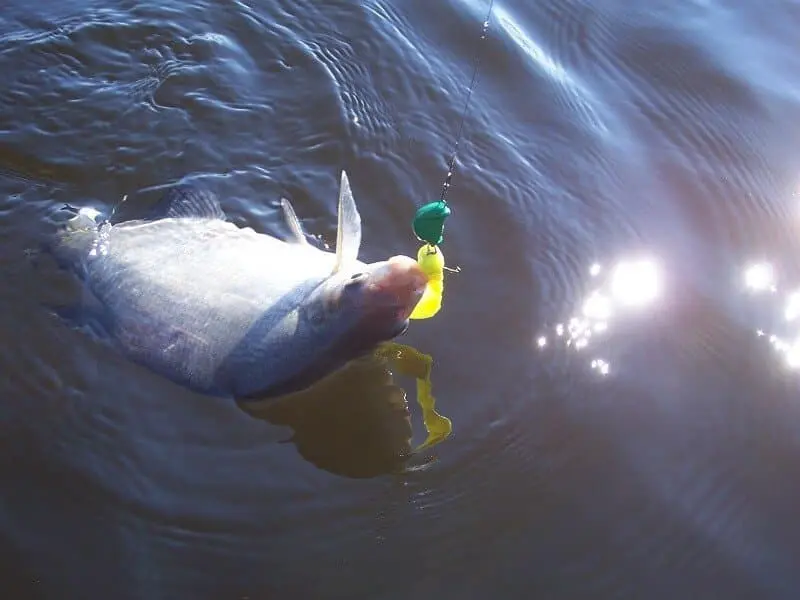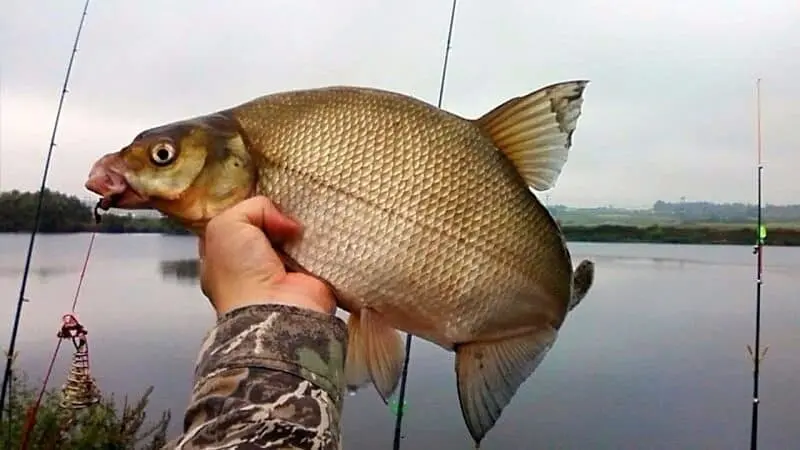Contents
- What does a bream eat
- Animal baits
- Herbal baits
- artificial bait
- What to catch bream in spring
- What to catch bream in summer
- What to catch bream in autumn
- What to catch bream in winter
- How to cook pasta for bream fishing
- How to cook potato dough for bream
- How to cook barley for bream fishing
- Catch nozzle for catching trophy bream
Bream is one of the most common fish in our waters. It got its name due to its habits during the spawning period. When it’s time to spawn, the bream splash on the surface, jump out of the water and plop back into the water noisily. They catch it on different types of tackle – on a float rod, donks and feeder. Since bream is a cautious fish, the choice of bait must be approached responsibly.
What does a bream eat
In its natural environment, the bream feeds on mosquito larvae and planktonic crustaceans. But you can catch it on a large number of different nozzles, both animal and vegetable origin.
Animal baits
At any time of the year, he readily responds to animal baits. The most common animal baits:
- Worm.
- Maggot.
- Bloodworm.

Also very catchy are their various combinations, called sandwiches. It is noticed that the use of sandwiches significantly increases activity in case of poor bite. There are days when the fish does not respond to one type of bait, but bites very willingly on a sandwich. The most common sandwiches:
- Worm plus maggot. Maggot is noticeably denser than a worm. Therefore, the maggot must be planted first, and then the worm. When cutting, the sting of the hook will pass through the worm more easily than through the maggot. This will increase the cutting efficiency.
- Worm plus bloodworm. The same rule applies here. First we plant a worm, and then a bloodworm. We plant bloodworms in a half ring.
- Maggot plus bloodworm. It’s the same here. First we plant a maggot, and then a bloodworm.
Herbal baits
With the advent of summer, bream is caught not only on animal baits, but also on vegetable ones. Moreover, the choice of plant baits is much larger than that of animals. The most common herbal tips:
- Corn.
- Peas.
- Wheat
- Pearl barley.
- Pasta.
artificial bait
On what only he does not bite. Recently, flavored foam has become a very popular nozzle for fishing. The whole secret of styrofoam fishing is in the correct supply of the bait. A prerequisite is the presence of a feeder with a short leash.
In June-July, the bream is successfully caught on the feeder and bottom rods. Therefore, when fishing with foam, these gears should be preferred.
When fishing, it is better to have foam plastic of different colors and smells with you, since it is not known what he will like on a particular day. His favorite flavors are garlic and corn.
What to catch bream in spring
In early spring, bream is best caught on baits of animal origin – on worms, maggots and bloodworms. At this time of the year, the bream will not pass by the crawling out – a large worm. You can get creeps at night. At this time, they crawl out of their burrows to the surface, where they are caught with their hands by the light of a lantern. Obtaining crawls is not an easy task, skill is needed here, as they are very careful and try to hide in their minks when there is a lot of noise.
What to catch bream in summer
In summer, bream fishing is especially productive. Having been ill after spawning, he begins to actively feed. Usually biting begins at the end of June and peaks in July-August. The bream pecks at this time early in the morning, late in the evening and at night. In summer, bream is equally well caught on plant baits and animals. As well as various combinations of them.
Steamed grains of barley or wheat are very effective when catching scavengers on small rivers. Depending on the time of steaming cereals in a thermos, you can get a nozzle of different hardness, from almost hard grains to soft ones.
A bream prefers a soft nozzle during periods of poor biting. Also, during a bad bite, you can use a combination of pearl barley and semolina talker.
On large rivers and reservoirs, bream is well caught on steamed peas, canned corn, and pasta.
An excellent attachment for catching large bream is a large bunch of dung worms.
What to catch bream in autumn
In autumn, the bream gathers in large flocks for wintering. Flocks can number several hundred heads. At this time, the bream is very cautious and it is not so easy to catch it. He prefers to eat high-calorie food, trying to put on as much fat as possible, so you need to catch him on animal baits. His bite is very capricious and it is not known what he will peck at – at bloodworms, at maggots or worms. Therefore, you need to take with you different nozzles in order to choose the right one.
What to catch bream in winter
The main nozzle for catching bream in winter is a bloodworm. Large larvae are used as bait, and small fodder bloodworms are used for bait. Large bream prefers large bait and you need to put a large bunch of bloodworms on the hook. In one bundle there can be up to 5-10 bloodworms. But small and medium bream, on the contrary, bite better when there are only 2-3 bloodworms on the hook.
Sometimes in winter, bream is well caught on maggots.
Also in winter, bream is caught on reelless mormyshkas. Butterflies come in many different shapes and colors. The most popular headless mormyshkas for bream fishing are devils.
How to cook pasta for bream fishing
One of the best baits for catching large bream, and indeed all white fish, is pasta. It is better to use star-shaped pasta, as they are easy to put on the hook. They are very easy to prepare:
- Pour desired amount of pasta into a mug.
- Fill with boiling water. Be sure to cover the top of the mug with something.
- We wait from 40 seconds to 1 minute. The time depends on the type of pasta. For example, for pasta “Pasta Zara” 40 seconds are enough, and for “Shchebekinsky” you need about a minute of time.
- Drain the boiling water and let the pasta brew a little under a closed lid for 10 minutes.
- Remove the lid and let the pasta rest for another 10-15 minutes. This is necessary so that they are slightly winded and become more dense.
- In order for the pasta not to stick together, they can be poured with a small amount of vegetable oil. The oil can be used with or without fragrance.
- Our nozzle is ready. Store pasta with the lid closed or it will harden.
How to cook potato dough for bream
Potato dough is a very catchy nozzle. It is prepared as follows:
- You need to cook one potato and mash it to a puree state. You can add a little water to make the puree more liquid.
- In the resulting puree, pour a tablespoon of flour.
- From the resulting porridge knead the dough. Everything, the nozzle is ready.
How to cook barley for bream fishing
Barley is not the main nozzle for catching it. But there are times when the bream simply does not take anything else. Barley for the nozzle is usually steamed in a thermos. It’s very easy to do this:
- Pour the right amount of barley into a thermos. Do not pour more than half the volume of the thermos, as barley swells greatly.
- Pour boiling water up to the top of the thermos.
- We are waiting 3 hours.
- The grains should be neither too soft nor too hard.

Catch nozzle for catching trophy bream
In summer, on the rivers, trophy bream is well caught on lard. But fat is not an independent bait, but works only in tandem with a feeder filled with bait. As bait, millet or pea porridge is usually used.
This gear works as follows. Near the feeder there are short five-centimeter leashes with hooks (usually 2 leashes are used). Porridge is stuffed into the feeder. She will be the main delicacy for bream. Having found a feeder with porridge, he begins to eat a delicacy, and together with them he sucks in a piece of lard.









